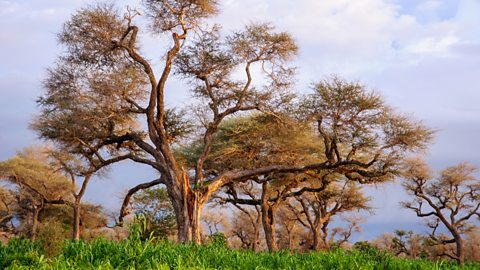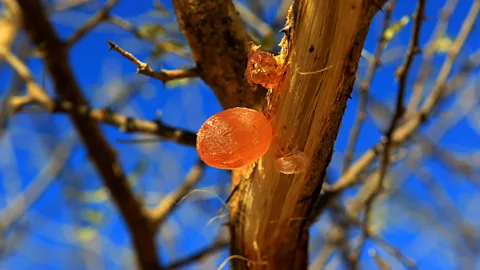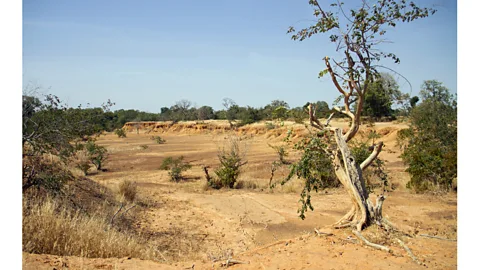The ancient trade holding back the Sahara Desert
 Getty Images
Getty ImagesFor millennia, the gum of the acacia tree has been prized for its unusual culinary and medical uses. Now, the trees are part of a continent-wide effort to hold back the Sahara Desert.
In the Malian bush, a scattering of acacia trees grow through the wild grass and shrubs that spread for miles across the semi-arid scrub. Herders graze cattle nearby and local people fetch firewood. The acacias are among the taller and faster-growing trees of this habitat, with old individuals reaching high above the surrounding scrub.
This is the Sahel, a savannah that stretches across six countries in mainland West Africa. This dry strip of land between the tropical rainforests to the south, and the Sahara to the north, sees just three months of rain a year. It’s a region that is changing quickly. Climate change has seen the Sahara Desert grow around 100km (62 miles) southward since 1950, and is expected to continue the same trend in the coming decades.
But the Sahel’s acacia trees, growing close to the boundary of the desert, are at the heart of a reviving ancient trade with the potential to stem the advance of the Sahara.
To see what is special about these trees, you have to tear off a strip of bark or make a small incision into the tree. The sap that exudes from the wound is a pinkish substance that dries into a round springy ball. This is gum arabic, and it comes from two species of tree found in the Sahel: Acacia senegal and Acacia seyal.
Old trade
For more than 2,500 years, this gum has been used for its properties to bind and emulsify substances (essentially to help them mix). The Ancient Egyptians used it in food, hieroglyphic paints and in their mummification ointments. Today gum arabic is used in a wide range of products, from soft drinks to pharmaceuticals.
 Reuters
ReutersMali was one of the two historic exporters of gum arabic, along with Senegal and Sudan, but the trade dwindled in the second half of the 20th Century. Until the 1960s, Mali had produced more than 10,000 tonnes of crude gum arabic a year. But a combination of natural and political factors destroyed the trade, such that by 1992 Mali exported only 32 tonnes of crude gum per year.
Meanwhile, from 1960 to the present day, Mali has lost 82% of its forest cover, according to Fatoumata Koné, the deputy technical secretary of the country's National Working Group on Sustainable Forest Management and Forest Certification. Nearly 450,000 hectares (1.1 million acres) have been lost between 2001 and 2018 due to several factors, including bush fires and tree clearance for fuel.
One initiative to combat this is the planting of 1,250 hectares (3,090 acres) of Acacia senegal in the Malian locality of Nara, near Mauritania. The Malian agricultural firm Déguessi Vert is working with the farmers and Mali’s principal agricultural research agency the Institute of Rural Economy on the plantation, which also aims to develop health infrastructure and schools in the villages involved in Mali Acacia Project, a program of 6,000 hectares (14,800 acres) of acacia in different parts of the country.
 Reuters
ReutersKoné says that the plantation is a success in both terms of reforestation and adaptation to climate change. “The acacias planted now produce the finest gum arabic, [which is highly] praised on the international market,” says Koné.
New growth
In the Kayes region, the harvesting of gum arabic has become an important source of income for locals, especially women. One kilogram of gum from the Acacia senegal tree sells for about 1,000 West African CFA francs ($1.8/£1.4). “Before, a lot of us depended on men for our money. But things have changed since we started selling gum arabic,” says Fanta Sissoko, a resident of Sefetou village in the Kayes region. “You just have to be courageous to go into the bush to pick gum arabic and you will have money without reaching out to your husband or to another man in the family, as we used to.”
Sissoko, a mother of six, and other women in her family pick gum in the bush from October when the rainy season ends. This is a good time for acacias to secrete gum until July when the rainy season begins. This year, she says she saved CFA600,000 ($1,100/£840). “I had never obtained such a large amount of money in any other activity and I wish to have more during the next campaign,” she says.
Gum arabic is also attracting young people from further afield to the Kayes region. “My dream was going to Italy by road,” says Mamoutou Cissé, a young internally displaced person who fled armed conflict in the region of Mopti in central Mali. “But I gave up the idea when I saw that other young people buy motorcycles just because they harvest gum arabic.”
 Getty Images
Getty ImagesIn the first year of his arrival in the Kayes region, Cissé says he saved nearly CFA1m ($1,800/£1,400) by selling gum arabic. “Everyday, I went out early in morning and only came back when the sun was about to set,” he says. “When I returned to my village, many young people wanted to follow my example.”
As well as bringing income through trade, the acacia trees also bring support from carbon credits via the World Bank’s BioCarbon Fund. Between 2007 and 2012, the plantations sequestered 190,000 tonnes of CO2, according to the Institute of Rural Economy.
The Malian authorities see the planting of acacias as an opportunity to reduce deforestation. As part of the African Union’s Great Green Wall project, Mali plans to plant thousands of hectares of acacia. This pan-African challenge is to create a new forest spanning the entire African continent – a strip of green that would connect the Senegalese capital, Dakar, in the west to Djibouti in the east. (Read more about Africa’s Great Green Wall.)
This would be more than 8,000km (4,970 miles) of vegetation that would help bind the soil, reducing erosion and retaining water, slowing the progression of the desert. More than 80,000 desert palms have already been planted, and over 45,000 hectares (110,000 acres) of desert has been re-greened with different trees including Acacia senegal and Acacia seyal, according to the conservation organisation Klorane Botanical Foundation.
 Reuters
ReutersIn Mali, the route of the Great Green Wall covers nearly 890km (550 miles), passing through the regions of Kayes and Koulikoro. The project is structured around 29 blocks, each one comprising a farm of approximately eight hectares of land developed for agriculture, tree planting and ranching. In total, there are expected to be 29 blocks in Mali that will involve 12,500 families. In 2015, the Malian state also began to invest CFA4bn ($7.2m/£5.6m) in planting acacia, training farmers in harvesting techniques and managing rural cooperatives in villages where gum arabic is grown.
Gum arabic farming still brings its challenges. The young plants are regularly destroyed by straying domestic animals, specifically when nomadic herders move between Mali and Mauritania. In addition, because of the region’s geology, the traditional shallow wells used by most of the villages in the area produce salt water that is unsuitable for irrigating the acacia trees, or any other kind of agriculture, says Sitafa Traoré, a forestry engineer working in the gum arabic trade in the Kayes region of western Mali. “It was therefore necessary to make deep boreholes with machines to find fresh water in order to maintain the young plants,” Traoré says.
But despite this, the gum arabic sector has already started to change the face of some Malian villages. National gum arabic exports have been growing rapidly, reaching nearly 2,500 tonnes in 2015 and 6,000 tonnes in 2016. Those involved in the trade, like Traoré, remain optimistic. In a region experiencing both climate and political instability, a trade that has been tested over centuries could help to bring security in more ways than one.
--
The emissions from travel it took to report this story were 19kg CO2, travelling by bus. The digital emissions from this story are an estimated 1.2g to 3.6g CO2 per page view. Find out more about how we calculated this figure here.
--
If you liked this story, sign up for the weekly bbc.com features newsletter, called “The Essential List”. A handpicked selection of stories from BBC Future, Culture, Worklife, and Travel, delivered to your inbox every Friday.
